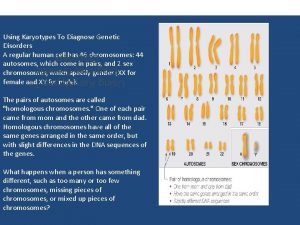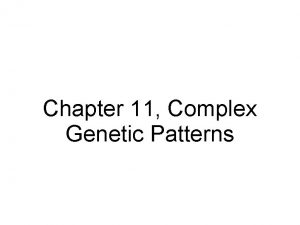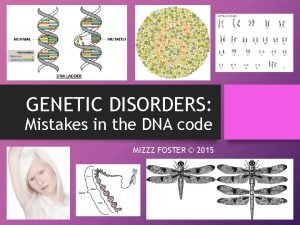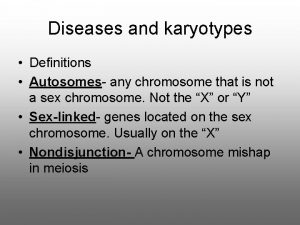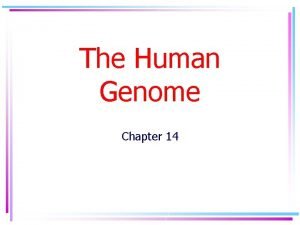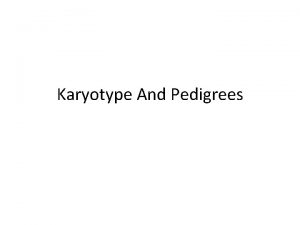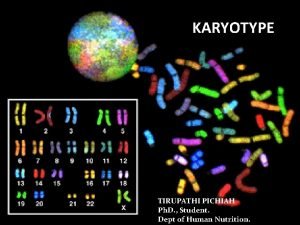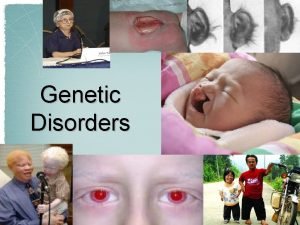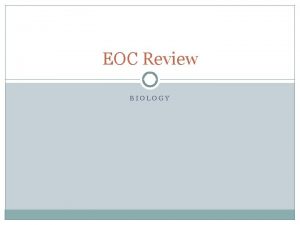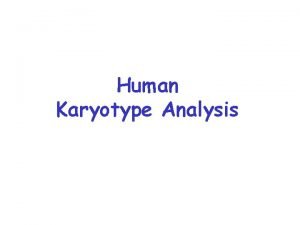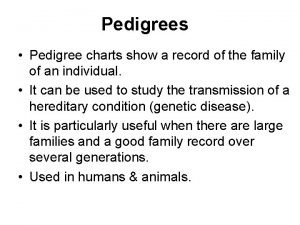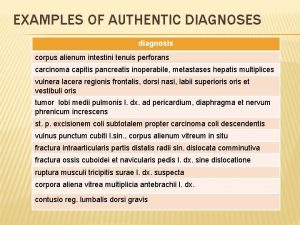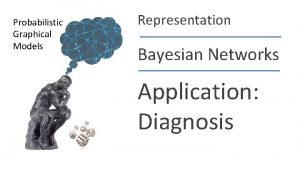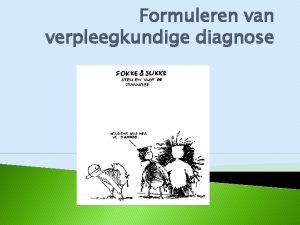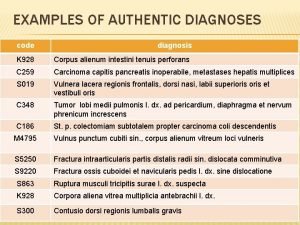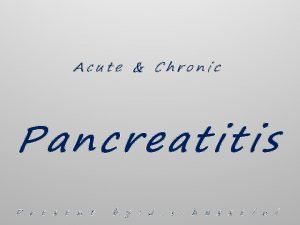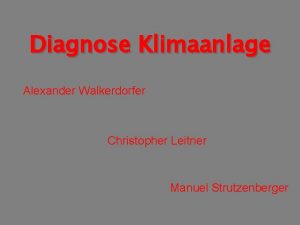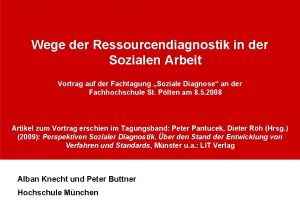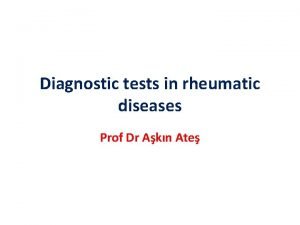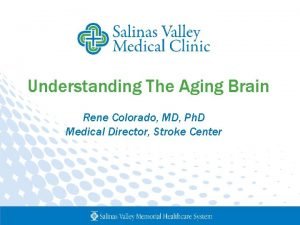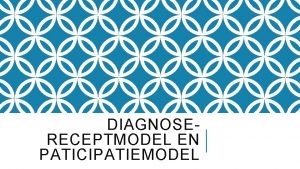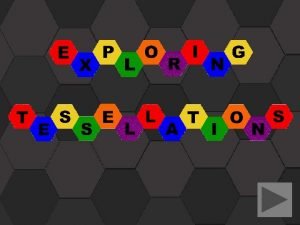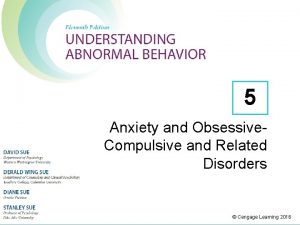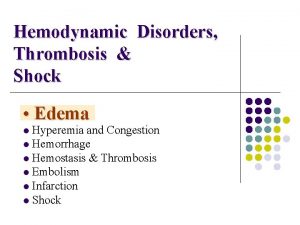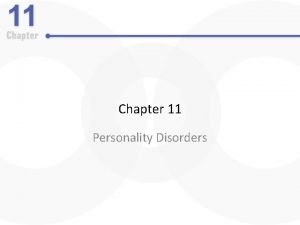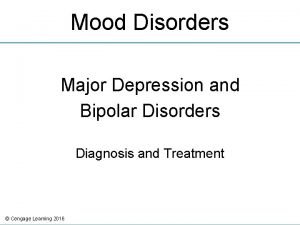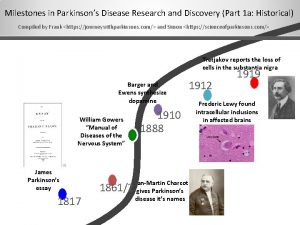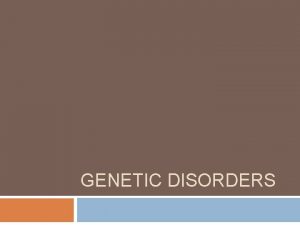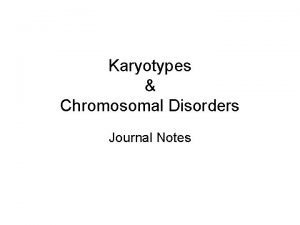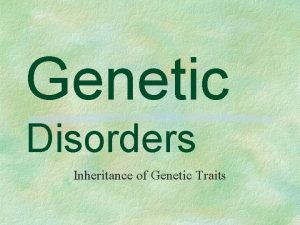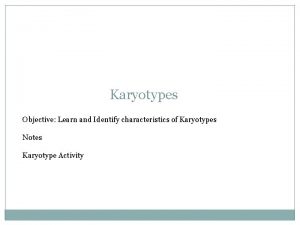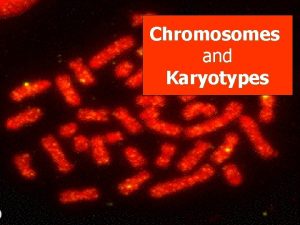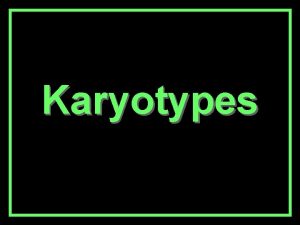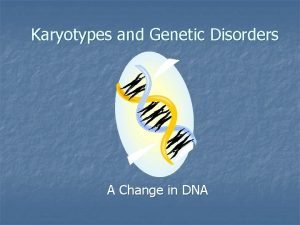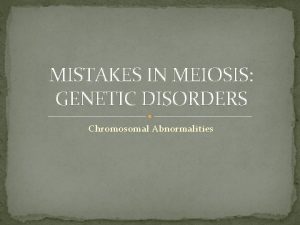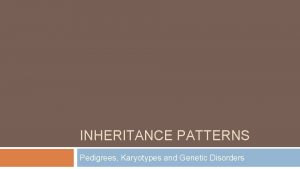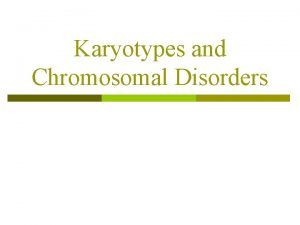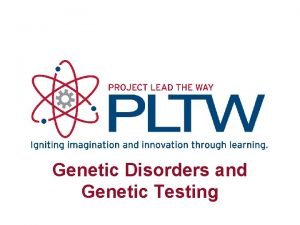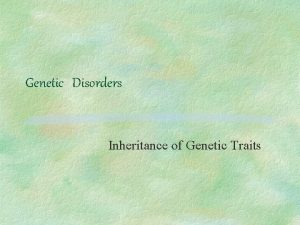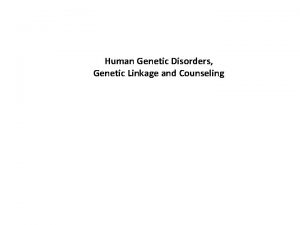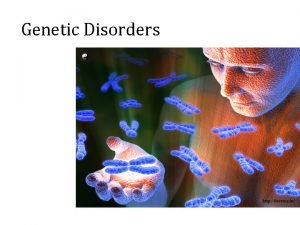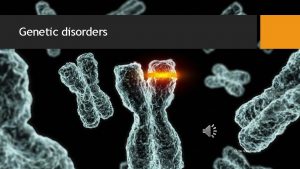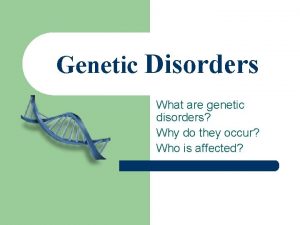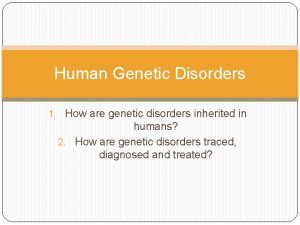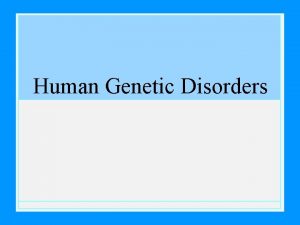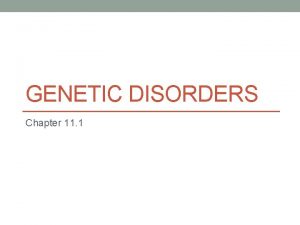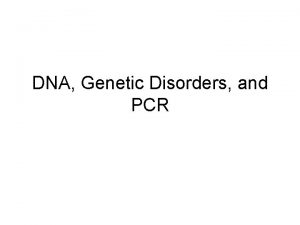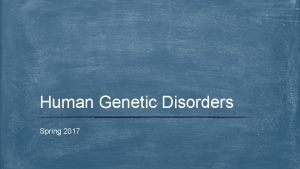Using Karyotypes To Diagnose Genetic Disorders A regular




















































- Slides: 52

Using Karyotypes To Diagnose Genetic Disorders A regular human cell has 46 chromosomes: 44 autosomes, which come in pairs, and 2 sex chromosomes, which specify gender (XX for female and XY for male). Using Karyotypes To Diagnose Genetic Disorders The pairs of autosomes are called "homologous chromosomes. " One of each pair came from mom and the other came from dad. Homologous chromosomes have all of the same genes arranged in the same order, but with slight differences in the DNA sequences of the genes. What happens when a person has something different, such as too many or too few chromosomes, missing pieces of chromosomes, or mixed up pieces of chromosomes?


So how are genes passed on from parent to child? Gene • Genes - sections of chromosomal DNA • One set of chromosomes is inherited from each parent • Therefore, for each pair of genes, one is inherited from a person’s mother, and one from their father • Sometimes the genes, or chromosomes they are on, have defects which are passed to offspring Chromosome Homologous Chromosome pair

Classification of genetic disorders Single Gene Disorders Mutations in single genes Male Chromosome disorders Whole chromosomes or sections messed up Chromosome number imbalance Due to nondisjunction during meiosis ex. Patau (Trisomy 13), Down syndrome (Trisomy 21)

Single gene disorders Caused by a mutant allele for a gene. Mutant allele may be the dominant or recessive one The three common types of single gene disorders are : • Autosomal recessive • Autosomal dominant • X-linked

Autosomal recessive inheritance Must have Homozygous Recessive Genotype Examples of Autosomal recessive diseases • Tay Sachs • Cystic fibrosis • Phenylketonuria (PKU) • Sickle Cell disease

Tay-Sachs 1 – 27 Ashkanazi Jews, Lousiana Cajuns and French Canadians – HIGHER FREQUENCY 1 - 250 in other population Heterozygotes have Selective Survival Advantage) Problems with brain cell membrane chemical build up causes blindness and seizures and early death Fig. 1. 2 ©Scion Publishing Ltd Photos (a) and (b) courtesy of Dr Tim David

Cystic fibrosis Most common genetic disease among Caucasians Faulty cell membrane transport protein Fig. 1. 2 ©Scion Publishing Ltd Photos (a) and (b) courtesy of Dr Tim David

Phenylketonuria “PKU” Lacks enzyme to breakdown amino acid phenylalanine which builds up in brain Fig. 1. 2 ©Scion Publishing Ltd Photos (a) and (b) courtesy of Dr Tim David

Sickle cell disease Ltd

AUTOSOMAL RECESSIVE INHERITANCE Parents Parent who are carriers for the same autosomal recessive condition have one copy of the usual form of the gene and one copy of an altered gene of the particular pair

AUTOSOMAL RECESSIVE INHERITANCE Parents Sperm/Eggs A parent who is a carrier passes on either the usual gene The other parent who is also a or the altered gene into the eggs carrier for the same condition passes on either the usual or sperm gene or the altered gene into his/her eggs or sperm

AUTOSOMAL RECESSIVE INHERITANCE Parents Sperm/Eggs Unaffected (carrier) Affected

D – No disease d- disease

Autosomal dominant inheritance Homo dominant or Heterozygous Examples of Autosomal Dominant Disorders • Achondroplasia (Dwarfism) • Huntington disease

Achondroplasia Dwarfism

Huntingtons chorea

Autosomal dominant inheritance Parents Gametes

Autosomal dominant inheritance Parents Gametes At conception Affected Unaffected

Dominant These individuals are called Heterozygotes with one copy of the altered gene they are affected Recessive Homozygotes must have two copies of the altered gene to be affected X-linked recessive Males with an altered gene on the Xchromosome are always affected


Autosomal recessive inheritance Must have Homozygous Recessive Genotype Examples of Autosomal recessive diseases • Tay Sachs • Cystic fibrosis • Phenylketonuria (PKU) • Sickle Cell disease

Autosomal dominant inheritance Homo dominant or Heterozygous Examples of Autosomal Dominant Disorders • Achondroplasia (Dwarfism) • Huntington disease

Sex-Linked Traits X chromosome Y chromosome


What are Sex Linked Traits? • Most traits we inherit are located on our autosomes. • BUT • Some traits are determined by genes located on the sex chromosomes. • These traits are called sex linked traits

The X chromosome is larger in size and has many more genes than the Y chromosome. Those traits with genes on the X sex chromosome are called X-linked traits X chromosome Y chromosome

Gene Linkage • Sex-linked traits were discovered in 1910 by Thomas Hunt Morgan who studied inheritance in fruit flies (Drosophila).

• Mendel’s Law of Independent Assortment applies to chromosomes which are assorted independently in meiosis. • Genes located close together are inherited together.


Sex linked Inheritance is different in males and females • Since males only have one X chromosome they can only receive one gene for these traits. • The gene is on the X chromosome they inherit from their mother • The Y chromosome, they got from their • father doesn’t have a copy of the gene

What he gets is what he is!!! • Males express all X-linked genes – • There’s no second allele to mask the effects of the only one he inherits on his X chromosomes

Males inherit one X chromosome • 2 Possible Genotypes: XᴿY or Xʳ Y

Females inherit two X chromosomes 3 Possible Genotypes: XᴿXᴿ XᴿXʳ Xʳ Xʳ

Sex-Linked Traits – • • 1. Color Blindness – recessive disorder 2. Hemophilia – blood clotting disorder 3. Baldness – recessive trait 4. Muscular dystrophy – recessive disorder

Beyond Mendel’s Principle of Dominance • • Incomplete Dominance Codominance Multiple Alleles Polygenic Traits

Incomplete dominance • Dominant allele doesn’t fully mask the expression of recessive allele. • A “blending” of both dominant and recessive alleles is seen as an intermediate (inbetween) phenotype in heterozygotes.







Incomplete Dominance vs. Codominance • Incomplete dominance – Heterozygote’s traits are a blend of the two alleles • Ex. Red X White flowers > Pink flowers • Codominance – Both alleles for gene are equally strong and are both seen • Ex. Red x White feathers > Both colors seen

• With incomplete dominance, a cross between organisms with two different phenotypes produces offspring with a third phenotype that is a blending of the parental traits. • With codominance, a cross between organisms with two different phenotypes produces offspring with a third phenotype in which both of the parental traits appear together.

Which inheritance pattern does each cross represent? Codominance or Incomplete Dominance 6/15/2021 X = 100%

Multiple Alleles • Many genes come in more than just 2 forms – there can be many alleles for one gene • The gene for blood type comes in 3 different allele forms • IA IB i


Polygenic Traits • More than one gene determines a trait • Usually the cause in traits with a lot of variation (height, skin color, hair color)


Phenotype results from the interaction of genes and environmental influences

1. Eye color is determined by many different genes Polygenic trait 2. Height and skin color comes in many forms on a continuum Polygenic trait 3. A hoo can have curly hair, spiked hair or a mix of curly and spiked Codominance – both traits seen 4. A horse has both red and white hairs making them look pinkish (roan). Codominance – both traits seen 5. A puppy inherits a gray coat from its black coat dad and white mom Incomplete dominance – blended traits 6. Snapdragons homozygous red crossed with pure white make pink Incomplete dominance – blended traits
 Using karyotypes to diagnose genetic disorders
Using karyotypes to diagnose genetic disorders Concept mapping chapter 11 genetic disorders
Concept mapping chapter 11 genetic disorders Is baldness dominant or recessive
Is baldness dominant or recessive Chromosomal mutation
Chromosomal mutation What is specation
What is specation What is the difference between genetic drift and gene flow
What is the difference between genetic drift and gene flow Genetic programming vs genetic algorithm
Genetic programming vs genetic algorithm Genetic programming vs genetic algorithm
Genetic programming vs genetic algorithm Genetic drift vs gene flow
Genetic drift vs gene flow Disorder
Disorder Pedigrees and karyotypes
Pedigrees and karyotypes Chapter 14 the human genome making karyotypes answer key
Chapter 14 the human genome making karyotypes answer key Pedigrees and karyotypes
Pedigrees and karyotypes Tirupathi pichiah
Tirupathi pichiah Pku karyotype
Pku karyotype Reading karyotypes
Reading karyotypes Klinefelter syndrome karyotype
Klinefelter syndrome karyotype Pedigrees and karyotypes
Pedigrees and karyotypes What does a pedigree chart show
What does a pedigree chart show Every linear grammar generates a regular language
Every linear grammar generates a regular language Cyber awareness diagnose
Cyber awareness diagnose Fractura ossis navicularis
Fractura ossis navicularis Diagnostic tool loopback adapter
Diagnostic tool loopback adapter Naive pathfinder
Naive pathfinder Inokuchi shunt
Inokuchi shunt Fokke en sukke stellen vlot de diagnose
Fokke en sukke stellen vlot de diagnose Pulmonary embolism shock
Pulmonary embolism shock Fractura ossium nasalium
Fractura ossium nasalium Gallstonee
Gallstonee Mallory weiss tear
Mallory weiss tear Klimaanlage diagnose drücke
Klimaanlage diagnose drücke Ressourceninterview schiepek
Ressourceninterview schiepek Signs of anemia
Signs of anemia Pancreatitis stool pictures
Pancreatitis stool pictures Verpleegkundige diagnose nanda
Verpleegkundige diagnose nanda Akn diagnose
Akn diagnose Prs-c ages 6-11
Prs-c ages 6-11 Diagnose it
Diagnose it Inhoud presentatie
Inhoud presentatie Eupf
Eupf Diagnose-recept model
Diagnose-recept model What shapes fit together without gaps
What shapes fit together without gaps Using system.collections
Using system.collections Defrost using internal heat is accomplished using
Defrost using internal heat is accomplished using Nail diseases and disorders milady
Nail diseases and disorders milady Multipath model of anxiety disorders
Multipath model of anxiety disorders L
L Cluster b personality disorder
Cluster b personality disorder Mood disorders
Mood disorders The uk national disorders
The uk national disorders Nuplazid
Nuplazid Chronic hyperplastic candidiasis
Chronic hyperplastic candidiasis Chapter 5 lesson 4 getting help answer key
Chapter 5 lesson 4 getting help answer key
